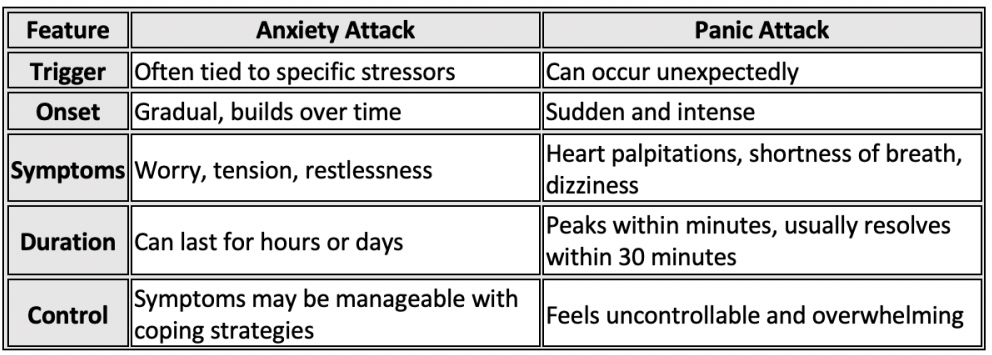Anxiety is a natural stress response, but when it becomes persistent, it can disrupt daily life, mental well-being, and emotional resilience. Understanding stress management techniques and mental health support options can help regain balance. Anxiety disorders affect millions of people worldwide, leading to excessive worry, physical discomfort, and emotional distress.
Understanding anxiety and learning how to manage it is essential for mental well-being. This article explores anxiety disorders, the differences between anxiety attacks and panic attacks, how Acceptance and Commitment Therapy (ACT) can help, and available treatment options.
Understanding Anxiety Disorders
What is Anxiety?
Anxiety1 is the body’s natural reaction to perceived threats, triggering physical and emotional responses. Short-term anxiety is normal, but anxiety disorders2 occur when fear and worry become excessive, persistent, and disruptive to daily life.
Types of Anxiety Disorders
- Generalized Anxiety Disorder (GAD): Characterized by chronic worry about various aspects of life, including work, health, and relationships.
- Social Anxiety Disorder (SAD): Involves intense fear of social situations, often leading to avoidance behaviors.
- Panic Disorder: Causes recurring panic attacks that include sudden, intense fear and physical symptoms.
- Obsessive-Compulsive Disorder (OCD): Marked by intrusive thoughts (obsessions) and repetitive behaviors (compulsions).
- Post-Traumatic Stress Disorder (PTSD): Develops after experiencing or witnessing a traumatic event, leading to flashbacks, avoidance, and heightened alertness.
- Phobias: Excessive fear of specific objects, places, or situations, such as heights, enclosed spaces, or flying.
Understanding the Range of Anxiety Disorders
Recognizing the type of anxiety disorder helps in determining the most effective treatment approach. Cognitive Behavioral Therapy (CBT) is widely used to help individuals identify and reframe negative thought patterns. Acceptance and Commitment Therapy (ACT) complements this approach, allowing individuals to accept stressors without letting them control their actions.
Anxiety Attacks vs. Panic Attacks: Symptoms and Coping Techniques
While both anxiety attacks and panic attacks involve intense fear and discomfort, they differ in duration, intensity, and triggers.

Recognizing Triggers
- Anxiety Attacks: Often triggered by work stress, relationship issues, or major life events. Symptoms build over time.
- Panic Attacks: May happen without warning, making them more intense and unpredictable.
How to Manage Each Type
- Anxiety Attacks: Deep breathing, grounding techniques, and cognitive reframing can help.
- Panic Attacks: Practicing controlled breathing and reminding yourself that the attack will pass can reduce intensity.
Acceptance and Commitment Therapy (ACT) for Anxiety

Acceptance and Commitment Therapy (ACT)3 is a therapeutic approach that helps individuals accept their thoughts and feelings rather than fighting them. It encourages people to commit to actions aligned with their values while allowing anxiety to exist without controlling their lives.
Core Principles of ACT
- Acceptance: Acknowledging anxious thoughts and feelings instead of suppressing them.
- Cognitive Defusion: Learning to see thoughts as passing mental events rather than absolute truths.
- Being Present: Practicing mindfulness to stay engaged in the current moment rather than getting caught in anxious thinking.
- Values-Based Action: Identifying what matters most and taking meaningful steps, even during periods of anxiety.
- Self-as-Context: Understanding that you are more than your anxious thoughts and emotions.
How ACT Differs from Traditional Therapies
Unlike CBT, which focuses on changing negative thought patterns, ACT teaches individuals how to coexist with uncomfortable thoughts and emotions while still engaging in meaningful actions. Psychological flexibility, the ability to adapt to change without being controlled by fear, is a key outcome of ACT.
Example: Instead of avoiding social interactions due to fear of judgment, ACT encourages individuals to acknowledge their anxiety while participating in social events that align with their values.
Managing Anxiety: Treatment, Stress Management, and Mindfulness Practices

Professional Treatments
- Cognitive Behavioral Therapy (CBT) is a widely used approach for stress management, emotional resilience, and reducing symptoms of anxiety disorders.
- ACT: Encourages acceptance of emotions while focusing on value-driven actions.
- Exposure Therapy: Gradual exposure to feared situations helps reduce anxiety over time.
Self-Help Strategies for Managing Anxiety
- Mindfulness techniques, such as meditation, guided breathing exercises, and progressive muscle relaxation, support emotional regulation and overall mental health support.
- Physical Activity: Regular exercise lowers cortisol levels and increases mood-boosting endorphins.
- Structured Routine: Maintaining a daily schedule can provide stability and predictability.
- Healthy Sleep Habits: Prioritizing quality sleep supports emotional regulation.
- Limiting Stimulants: Reducing caffeine and alcohol intake can minimize anxiety symptoms.
- Journaling: Writing down thoughts helps process emotions and identify triggers.
Acknowledging anxiety is the first step toward better mental health support. Individuals can build resilience and regain control over their well-being with mindfulness techniques, cognitive-behavioral therapy, and stress management strategies. Anxiety does not define a person, and with appropriate strategies, it’s possible to manage it effectively.
I’ve received many questions from families about how anxiety affects teens’ sleep and daily life. So, to support teens (and adults) struggling with anxiety, I wrote The Only Anxiety Book for Teens You Will Ever Need, a practical workbook filled with strategies to understand anxiety, identify triggers, and take actionable steps toward well-being. I invite you to explore this resource.
If you found this article helpful, please share it with someone who might need it. Do you have any experience to add? Please share it in the comments. I would love to hear from you!
About the Author
Carla Picolli is a psychologist, sleep expert, author, and mental health advocate. With over two decades of experience in mental health and wellness, Carla helps individuals build sustainable habits for a healthier, happier life.
References:
- https://www.apa.org/topics/anxiety
- https://www.nimh.nih.gov/health/topics/anxiety-disorders
- Harris, R. (2019). ACT made simple: An easy-to-read primer on acceptance and commitment therapy. New Harbinger Publications.
- Anxiety and Depression Association of America. (2023). Facts and statistics. https://adaa.org/understanding-anxiety/facts-statistics
- Mayo Clinic. (2023). Anxiety disorders. https://www.mayoclinic.org/diseases-conditions/anxiety/symptoms-causes/syc-20350961


Dear Carla,
Reading your insightful article, “Recognizing Anxiety: Understanding, Managing, and Overcoming It.” The comprehensive exploration of anxiety disorders and available treatment approaches was both enlightening and comforting.
I particularly appreciated the way you delineated the various types of anxiety disorders, such as Generalized Anxiety Disorder, Social Anxiety Disorder, and Panic Disorder. This clear categorization not only enhances understanding but also fosters empathy for those who face these challenges. Your explanation of Acceptance and Commitment Therapy (ACT) resonated deeply with me. The emphasis on accepting one’s thoughts and feelings, rather than resisting them, aligns with the concept of radical acceptance—a practice I have found transformative in my own journey.
Your comparison between anxiety attacks and panic attacks was particularly illuminating. I remember a time when I experienced what I thought was a heart attack, only to learn later that it was a panic attack. Understanding the distinctions you described would have provided much-needed clarity during this overwhelming time.
I was also struck by your discussion of the core tenets of ACT, particularly the idea of cognitive diffusion. Recognizing thoughts as fleeting events rather than absolute truths is a powerful shift in perspective. It reminds me of the Serenity Prayer, which emphasizes accepting what we cannot change and finding the courage to change what we can.
One area I would like to see expanded upon is the practical application of ACT in everyday life. Perhaps sharing personal anecdotes or case studies could provide readers with a more tangible connection to the benefits of therapy.
I’m curious, have you encountered any common misconceptions about anxiety disorders in your practice? Additionally, how do you suggest individuals balance accepting their anxiety with pursuing change?
Thank you for shedding light on such a timely topic. Your work not only educates but also offers hope and guidance to those navigating the complexities of anxiety.
Warm regards,
Mitia
Thank you for your thoughtful and deeply insightful response, Mitia! I truly appreciate it! I love your connection to the Serenity Prayer, it beautifully aligns with ACT’s core principles.
You bring up an excellent point about the practical application of ACT in daily life. Here is an example and I’ll definitely keep this in mind for future content.
Waiting to feel confident before taking action often keeps us stuck, but ACT teaches us that we can move forward even with fear. Instead of letting anxiety dictate decisions, remind yourself, ‘I can take action even if I feel afraid.’ Start small: sign up for one class, write for five minutes, or take the first step toward your goal. The key is to act in alignment with your values, not your momentary emotions. Fear doesn’t have to disappear for progress to happen. You can bring it along for the ride.
As for common misconceptions about anxiety disorders, one of the biggest I’ve encountered is the idea that anxiety is just overthinking or a lack of willpower when, in reality, it’s a complex interplay of biology, environment, and thought patterns. Balancing acceptance with change means recognizing anxiety as a part of the human experience while still creating space for growth. Small, intentional steps, whether through mindfulness, self-compassion, or shifting perspective, help build resilience over time.
Thank you again for your kind words and for sharing your insights!
This article really struck a chord with me. I appreciate how it breaks down the complex nature of anxiety into understandable part from distinguishing between anxiety and panic attacks to exploring practical therapies like ACT. The clear, compassionate advice on using mindfulness and self-help strategies feels like a genuine roadmap to regaining control. It’s a comforting reminder that while anxiety can be overwhelming, it doesn’t define us, and with the right tools, we can find balance and resilience.
Thank you for your kind words, Dan! I’m so glad the article resonated with you. Have a great weekend!